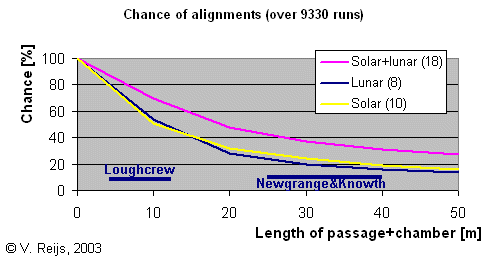As an example; when having 10 [m]
length passages+chambers with randomly build direction, the chance that
it is pointed to a celestial event is 70% when looking at all celestial
events (10 solar and 8 lunar) and around 50% when looking at only (10)
solar or only (8) lunar events.
So the above gives us an idea of the chance when varying the
passage+chamber length, the number of celestial events and using the
sky-window method as the area which the celestial object can cross.
Chance with several window types
If we change the methodology of window through:
- a sky
window (minimum and maximum azimuth and
apparent altitude),
- the sky window corners (the corners of the sky window with have
minimum azimuth&apparent altitude and maximum
azimuth&apparent alttiude)
- an azimuth window (no minimum and maximum
apparent altitude) or
- an average azimuth, the chances changes.
See the following table (the length of
passage+chamber is randomly varied between 4 and 12 [m] as lengths seen
at Loughcrew
cairns):
|
Solar+Lunar
(18)
events
|
Lunar
(8)
events
|
Solar
(10)
events
|
| sky window |
76%
|
61%
|
62%
|
sky
window corners
|
|
|
|
azimuth
window
|
50%
|
32%
|
37%
|
average
azimuth
|
10%
|
4%
|
6%
|
Conclusions
